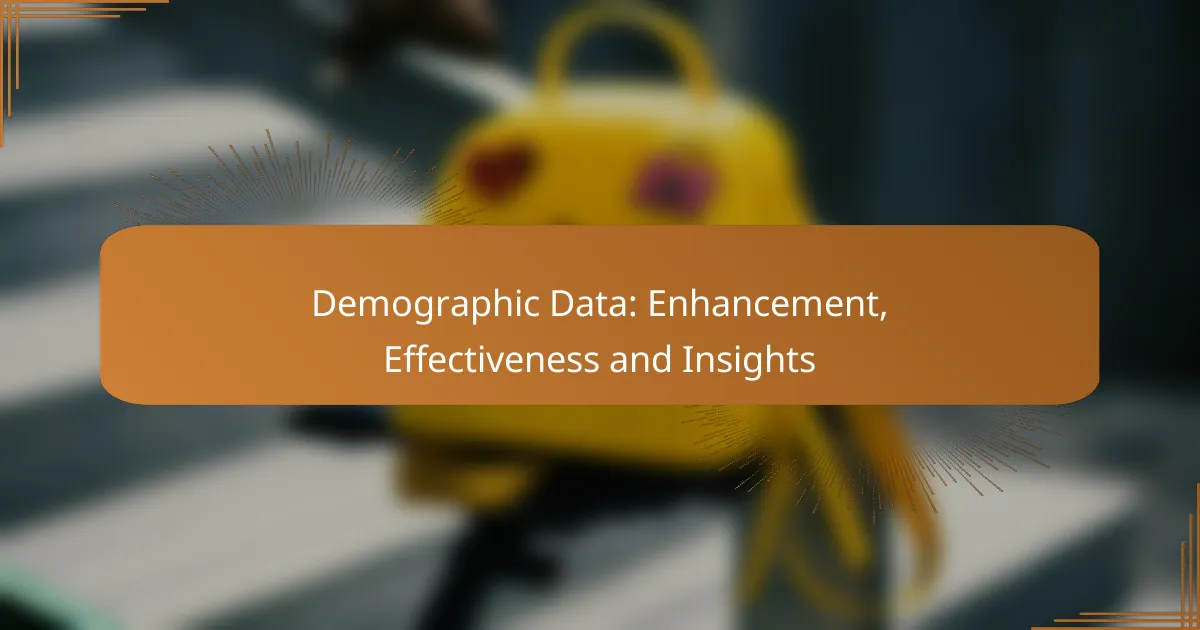Psychographics play a crucial role in enhancing advertising campaigns by enabling marketers to craft messages that resonate with the attitudes, values, and lifestyles of their target audience. By understanding key factors such as values, beliefs, and personality traits, marketers can create more relevant and impactful campaigns that foster deeper connections with consumers. Collecting psychographic data allows for insights into consumer behavior, ultimately leading to improved campaign performance.

How can psychographics enhance display advertising campaigns?
Psychographics can significantly enhance display advertising campaigns by allowing marketers to tailor their messages based on the attitudes, values, and lifestyles of their target audience. This deeper understanding fosters more relevant and impactful advertising, leading to better overall campaign performance.
Targeted messaging
Targeted messaging involves crafting advertisements that resonate with specific psychographic profiles. By analyzing consumer interests and preferences, brands can create personalized content that speaks directly to their audience’s motivations. For instance, a fitness brand might focus on health-conscious individuals by highlighting eco-friendly products.
To implement targeted messaging effectively, consider segmenting your audience based on psychographic data. Utilize surveys, social media insights, and customer feedback to gather information that informs your messaging strategy.
Improved audience engagement
Improved audience engagement results from delivering content that aligns with the values and interests of your target demographic. When consumers feel understood, they are more likely to interact with ads, share content, and develop a connection with the brand. For example, campaigns that emphasize sustainability can engage environmentally conscious consumers more effectively.
To boost engagement, focus on storytelling that reflects the lifestyle and aspirations of your audience. Use visuals and language that resonate with their psychographic traits, creating a more immersive experience.
Increased conversion rates
Increased conversion rates often follow when campaigns leverage psychographics to connect with consumers on a deeper level. Ads that align with personal values can lead to higher click-through rates and ultimately more sales. For instance, a campaign targeting tech-savvy millennials with innovative product features may yield better results than generic advertisements.
To maximize conversion rates, continuously test and optimize your ads based on psychographic insights. Track performance metrics and adjust your strategies to ensure your messaging remains relevant and effective in driving action.

What are the key psychographic factors to consider?
Key psychographic factors include values and beliefs, lifestyle choices, and personality traits. Understanding these elements helps marketers connect with their audience on a deeper level, tailoring campaigns to resonate with specific motivations and preferences.
Values and beliefs
Values and beliefs shape how individuals perceive the world and make decisions. They often stem from cultural, religious, or personal experiences and can significantly influence purchasing behavior. For example, consumers who prioritize sustainability may favor brands that demonstrate eco-friendly practices.
To effectively leverage values and beliefs, conduct surveys or focus groups to identify what matters most to your target audience. Aligning your messaging with these core values can enhance brand loyalty and engagement.
Lifestyle choices
Lifestyle choices encompass daily habits, activities, and consumption patterns that reflect an individual’s preferences and priorities. These choices can include diet, exercise, travel, and entertainment, which all provide insight into potential purchasing behaviors. For instance, health-conscious consumers may invest in organic products and fitness-related services.
Understanding lifestyle choices allows marketers to segment their audience more effectively. Tailoring campaigns to specific lifestyles can lead to more relevant messaging and higher conversion rates.
Personality traits
Personality traits refer to the consistent patterns of thoughts, feelings, and behaviors that characterize an individual. Traits such as openness, conscientiousness, and extroversion can influence how consumers interact with brands and make purchasing decisions. For example, extroverted individuals may be drawn to brands that promote social experiences.
To connect with different personality types, consider using targeted messaging that resonates with specific traits. This approach can enhance the effectiveness of marketing campaigns by appealing directly to the unique preferences of each segment.

How to collect psychographic data for audience analysis?
Collecting psychographic data involves understanding the attitudes, values, and interests of your audience. This data can be gathered through various methods that provide insights into consumer behavior and preferences.
Surveys and questionnaires
Surveys and questionnaires are effective tools for gathering psychographic data directly from your audience. They can be distributed online or in person and should include questions that explore values, lifestyles, and motivations.
To maximize response rates, keep surveys concise and focused. Aim for 10-15 questions that can be completed in under 5 minutes. Consider using a mix of multiple-choice and open-ended questions to capture both quantitative and qualitative data.
Social media analysis
Social media analysis involves examining user interactions and content shared on platforms like Facebook, Instagram, and Twitter. This method helps identify trends, interests, and sentiments within your target audience.
Utilize social listening tools to track mentions, hashtags, and engagement metrics. Look for patterns in the types of content that resonate with your audience, such as posts about sustainability or lifestyle choices, to better understand their psychographics.
Customer interviews
Customer interviews provide in-depth insights into the psychographics of your audience. Conducting one-on-one interviews allows you to explore motivations and preferences in detail.
Prepare open-ended questions that encourage discussion about values, challenges, and aspirations. Aim for a diverse sample of customers to capture a wide range of perspectives. Record and analyze these interviews to identify common themes and insights that can inform your campaigns.

What are effective strategies for leveraging psychographics in campaigns?
Effective strategies for leveraging psychographics in campaigns include understanding audience motivations, values, and lifestyles to create targeted messaging. By utilizing psychographic data, marketers can enhance engagement and improve conversion rates through tailored approaches.
Segmenting audiences
Segmenting audiences based on psychographics involves categorizing them according to shared values, interests, and lifestyles. This allows for more precise targeting, as different segments may respond uniquely to various messaging strategies. For instance, a brand targeting environmentally conscious consumers might emphasize sustainability in its campaigns.
To effectively segment, consider using surveys or social media analytics to gather insights on audience preferences. Aim for segments that are large enough to justify tailored campaigns but specific enough to resonate with their unique characteristics.
Personalized content creation
Personalized content creation is about crafting messages that speak directly to the interests and values of specific audience segments. This can include customized emails, targeted social media ads, or tailored blog posts that reflect the psychographic profiles of the audience. For example, a fitness brand might create content that appeals to both casual gym-goers and serious athletes by addressing their distinct motivations.
Utilize data analytics to track engagement and refine content strategies. Regularly update your content to reflect changing audience preferences and ensure it remains relevant and engaging.
Behavioral targeting
Behavioral targeting leverages psychographic insights to deliver ads based on users’ past behaviors and interactions. By analyzing data such as browsing history and purchase patterns, marketers can serve highly relevant ads that align with users’ interests. For instance, a travel company might target ads for adventure trips to users who have previously shown interest in outdoor activities.
To implement effective behavioral targeting, ensure compliance with privacy regulations and provide users with clear options to manage their data preferences. This builds trust and enhances the likelihood of positive engagement with your campaigns.

How do psychographics compare to demographics in advertising?
Psychographics focus on consumer attitudes, values, and lifestyles, while demographics center on statistical characteristics like age, gender, and income. Understanding both can enhance advertising effectiveness by providing a more comprehensive view of the target audience.
Deeper insights into consumer behavior
Psychographics offer a nuanced understanding of why consumers make certain choices, revealing motivations that demographics alone cannot. For instance, two individuals may share the same age and income but have vastly different purchasing behaviors based on their values or interests.
By analyzing psychographic data, advertisers can identify trends and preferences that inform product development and marketing strategies. This deeper insight can lead to more relevant messaging that resonates with the audience on an emotional level.
Enhanced targeting precision
Utilizing psychographics allows for more precise targeting in advertising campaigns. Instead of targeting broad demographic groups, marketers can tailor their messages to specific psychographic segments, improving engagement rates and conversion potential.
For example, a brand selling eco-friendly products might target consumers who prioritize sustainability and environmental impact, regardless of their age or income. This targeted approach can lead to higher return on investment (ROI) by ensuring that marketing efforts reach those most likely to respond positively.

What tools can assist in psychographic analysis?
Several tools can effectively assist in psychographic analysis by gathering and interpreting data about consumer attitudes, interests, and behaviors. These tools help marketers create targeted campaigns that resonate with their audience’s values and preferences.
Qualtrics
Qualtrics is a robust platform that specializes in experience management and offers advanced survey capabilities. It allows users to design detailed surveys that can capture psychographic data through customizable questions and response formats. The platform also provides analytics tools to interpret the results, making it easier to understand audience motivations.
When using Qualtrics, consider leveraging its segmentation features to analyze different audience groups. This can help identify distinct psychographic profiles, enabling more tailored marketing strategies. Be mindful of question phrasing to avoid bias in responses.
SurveyMonkey
SurveyMonkey is a user-friendly survey tool that can be utilized for psychographic analysis by collecting consumer feedback on attitudes and preferences. Its templates and question types make it easy to design surveys that probe deeper into the motivations behind consumer choices.
To maximize the effectiveness of SurveyMonkey, focus on clear and concise questions that encourage honest responses. Utilize its reporting features to visualize data trends and insights, which can guide your marketing decisions. Avoid overly complex surveys, as they may lead to lower response rates.
Google Analytics
Google Analytics is primarily known for web analytics but can also provide valuable insights into psychographics through user behavior tracking. By analyzing metrics such as session duration, bounce rates, and user demographics, marketers can infer interests and preferences that align with psychographic profiles.
To effectively use Google Analytics for psychographic analysis, set up goals and events that reflect user engagement with content. This data can reveal what resonates with your audience, allowing for more effective targeting. Regularly review your analytics to adapt strategies based on changing consumer behaviors.

What are the challenges of using psychographics in advertising?
Using psychographics in advertising presents several challenges, including accurately identifying and interpreting consumer motivations, values, and lifestyles. Marketers must navigate the complexities of data collection and analysis while ensuring their insights translate into effective campaigns.
Data Collection Difficulties
Gathering psychographic data can be challenging due to its subjective nature. Unlike demographic data, which is often straightforward to obtain, psychographics require deeper insights into consumer behavior and preferences. Surveys, interviews, and focus groups can be time-consuming and may not always yield reliable results.
Additionally, privacy concerns and regulations like GDPR in Europe can limit access to personal data, making it harder for advertisers to build comprehensive psychographic profiles. Companies must balance the need for detailed insights with ethical considerations and compliance with data protection laws.
Interpretation of Insights
Interpreting psychographic data accurately is crucial but often difficult. Marketers must differentiate between correlation and causation, ensuring that they do not misinterpret consumer motivations. Misunderstanding these insights can lead to ineffective campaigns that fail to resonate with the target audience.
It’s essential to validate findings through multiple sources and methods, such as A/B testing or cross-referencing with behavioral data. This approach helps ensure that the insights derived from psychographics are actionable and relevant.
Integration with Other Data Types
Integrating psychographic data with demographic and behavioral data can be complex. Marketers need to create a cohesive strategy that leverages all data types effectively. This requires a clear understanding of how different data sets interact and influence consumer behavior.
To achieve this integration, companies can use advanced analytics tools and platforms that allow for seamless data merging. Regularly updating and refining these data sets is also crucial to maintain accuracy and relevance in campaigns.
Resource Allocation
Investing in psychographic research can be resource-intensive, requiring both time and financial commitment. Companies must weigh the potential benefits against the costs involved in conducting thorough psychographic analysis.
To optimize resource allocation, businesses should prioritize segments where psychographic insights can significantly enhance campaign effectiveness. Focusing on high-value customer segments can lead to better returns on investment and more impactful advertising efforts.


